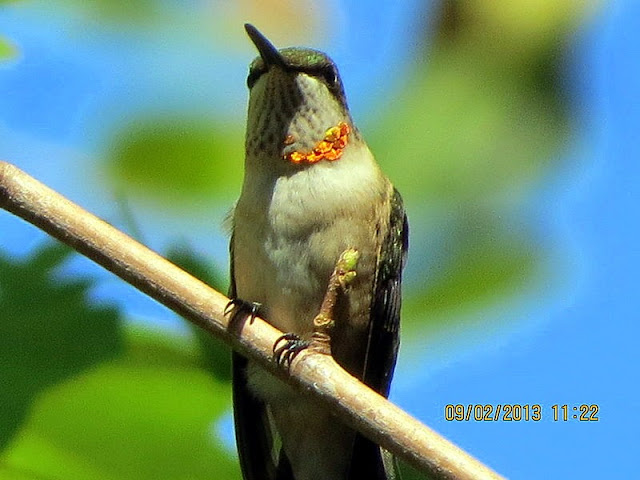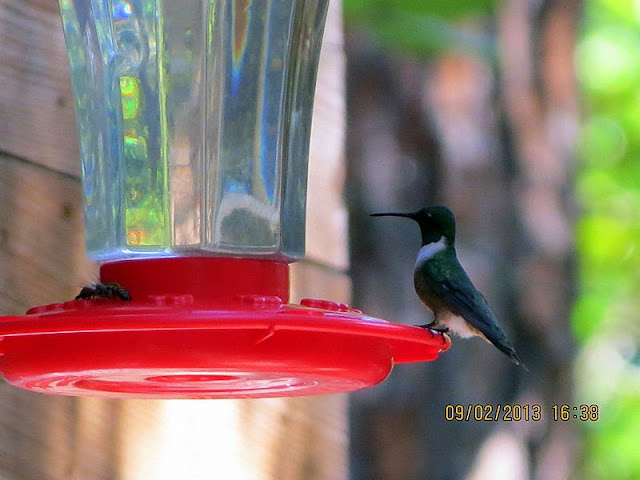Hi Everybody!!
Good News: More hummers came in today. I call it the second wave! The joint is really jumping now. They are whistling, clicking and zipping through the air. Your photostudy tonight is "totally hummingbirds" If You do not like the little mini helicopters, skip this post as it is total bird! These tiny jewels are incredibly agile and have been studied and documented by: Doug Altshuler. (See info section below for link to 5 minute clip). Thinking of jewels, the star of tonight's photostudy is a juvenile just beginning to get his "rubies". The ruby red throat feathers are called: gorget feathers.
Delight in the night and Enjoy!
I located the following in Google Search:
Video: Incredible Agility - Hummingbirds: Magic in the Air - Doug ...
www.pbs.org/wnet/nature/episodes/hummingbirds-magic-in.../5441/Biologist Doug Altshuler has turned his lab into a kind of hummingbird training center, where he can test the ... Tags: agility, birds, flight, hovering, hummingbirds...
http://www.pbs.org/wnet/nature/episodes/hummingbirds-magic-in-the-air/video-incredible-agility/5441/
Hummingbirds: Magic in the Air
Biologist Doug Altshuler has turned his lab into a kind of hummingbird training center, where he can test the limits of their aerial agility. The key, he says, is hovering.
Hummingbird
From Wikipedia, the free encyclopedia
Aerodynamics of flight
Aerodynamics of flight
Hummingbird flight has been studied intensively from an aerodynamic perspective using wind tunnels and high-speed video cameras.
Writing in Nature, the biomechanist Douglas Warrick and coworkers studied the Rufous Hummingbird, Selasphorus rufus, in a wind tunnel using particle image velocimetrytechniques and investigated the lift generated on the bird's upstroke and downstroke. They concluded that their subjects produced 75% of their weight support during the downstroke and 25% during the upstroke. Many earlier studies had assumed (implicitly or explicitly) that liftwas generated equally during the two phases of the wingbeat cycle, as is the case of insects of a similar size. This finding shows that hummingbirds' hovering is similar to, but distinct from, that of hovering insects such as the hawk moths.[15]
The Giant Hummingbird's wings beat is as low as 12 beats per second, the wings of medium-sized hummingbirds beat about 20 to 30 beats per second and the smallest can reach 100 beats per second during courtship displays.
A slow motion video has shown how the hummingbirds deal with water when they are flying. To remove the water from their heads, they shake their heads and body, similar to a dog shaking to shed water.[16]
Metabolism
With the exception of insects, hummingbirds while in flight have the highestmetabolism of all animals, a necessity in order to support the rapid beating of their wings. Their heart rate can reach as high as 1,260 beats per minute, a rate once measured in a Blue-throated Hummingbird.[17] They also consume more than their own weight in nectar each day, and to do so they must visit hundreds of flowers daily. Hummingbirds are continuously hours away from starving to death, and are able to store just enough energy to survive overnight.[18]
Hummingbirds are capable of slowing down their metabolism at night, or any other time food is not readily available. They enter a hibernation-like state known as torpor. During torpor, the heart rate and rate of breathing are both slowed dramatically (the heart rate to roughly 50 to 180 beats per minute), reducing the need for food.
The dynamic range of metabolic rates in hummingbirds[19] requires a corresponding dynamic range in kidney function.[20] The glomerulus is a cluster of capillaries in thenephrons of the kidney that removes certain substances from the blood, like a filtration mechanism. The rate at which blood is processed is called the glomerular filtration rate (GFR). Most often these fluids are reabsorbed by the kidneys. During torpor, to prevent dehydration, the GFR slows, preserving necessities for the body such as glucose, water and salts. GFR also slows when a bird is undergoing water deprivation. The interruption of GFR is a survival and physiological mechanism unique to hummingbirds.[20]
Studies of hummingbirds' metabolisms are highly relevant to the question of how amigrating Ruby-throated Hummingbird can cross 800 km (500 mi) of the Gulf of Mexicoon a nonstop flight. This hummingbird, like other birds preparing to migrate, stores up fat to serve as fuel, thereby augmenting its weight by as much as 100 percent and hence increasing the bird's potential flying time.[21]
Migration
Most hummingbirds of the U.S. and Canada migrate south in fall to spend the winter in northern Mexico or Central America. A few southern South American species also move to the tropics in the southern winter. A few species are year-round residents in the warmer coastal and southern desert regions on the USA. Among these is Rufous Hummingbird, a winter resident in Florida, parts of the Gulf coast, and up to the lowlands of coastal South Carolina/Georgia, and Anna's Hummingbird, a common resident from California inland to southern Arizona and north to southwestern coastal British Columbia.
The Rufous Hummingbird is one of several species that breed in North America and are wintering in increasing numbers in the warm subtropical southeastern United States, rather than in tropical Mexico. The Rufous Hummingbird nests farther north than any other species and must tolerate occasional temperatures below freezing on its breeding grounds. This cold hardiness enables it to survive brief temperatures below freezing, provided that adequate shelter and feeders are available.
Feeders and artificial nectar
Hummingbirds will also take sugar-water from bird feeders. Such feeders allow people to observe and enjoy hummingbirds up close while providing the birds with a reliable source of energy, especially when flower blossoms are less abundant.
White granulated sugar is the best sweetener to use in hummingbird feeders. A ratio of 1 cup sugar to 4 cups water is a common recipe.[37] Boiling and then cooling this mixture before use has been recommended to help deter the growth of bacteria and yeasts. Powdered sugars contain corn starch as an anti-caking agent; this additive can contribute to premature fermentation of the solution. Brown, turbinado, and "raw" sugars contain iron, which can be deadly to hummingbirds if consumed over long periods.[38] Honey is made by bees from the nectar of flowers, but it is not good to use in feeders because when it is diluted with water,microorganisms easily grow in it, causing it to spoil rapidly.[39][40][41]
Red food dye is often added to homemade solutions. Commercial products sold as "instant nectar" or "hummingbird food" may also contain preservatives and/or artificial flavors as well as dyes. The long-term effects of these additives on hummingbirds have not been studied, but studies on laboratory animals indicate the potential to cause disease and premature mortality at high consumption rates.[42] Although some commercial products contain small amounts of nutritional additives, hummingbirds obtain all necessary nutrients from the insects they eat. This renders the added nutrients unnecessary.[28]
Other animals also visit hummingbird feeders. Bees, wasps, and ants are attracted to the sugar-water and may crawl into the feeder, where they may become trapped and drown. Orioles, woodpeckers, bananaquits, and other larger animals are known to drink from hummingbird feeders, sometimes tipping them and draining the liquid.[43] In the southwestern United States, two species of nectar-drinking bats (Leptonycteris yerbabuenae and Choeronycteris mexicana) visit hummingbird feeders to supplement their natural diet of nectar and pollen from saguaro cacti and agaves.[44]
Wing structure and colors
Many of the hummingbird species have bright plumage with exotic coloration. In many species, the coloring does not come frompigmentation in the feather structure, but instead from prism-like cells within the top layers of the feathers. When light hits these cells, it is split into wavelengths that reflect to the observer in varying degrees of intensity. The Hummingbird feather structure acts as a diffraction grating. The result is that, merely by shifting position, a muted-looking bird will suddenly become fiery red or vivid green. However, not all hummingbird colors are due to the prism feather structure. The rusty browns of Allen's and Rufous Hummingbirds come from pigmentation. Iridescent hummingbird colors actually result from a combination of refraction and pigmentation, since the diffraction structures themselves are made of melanin, a pigment.[36]
...this is brendasue signing off from Rainbow Creek. See You next time! Thank You, my friends, for all the +1s and comments and love for the little hummingbirds. (I am trying to bring You the complete migration (!), at least one month to go). With the new arrivals, there has been a shift in power. The bees no longer rule! More birds get together and click the bees away from the feeders! From the Back Door at Kates Cabin To You: Hello!
Closing Bonus: Elvis, the King!
O+O







































































































No comments:
Post a Comment
Hi Everybody! Please say hello and follow so I know you are here! Due to the inconsideration of people trying to put commercials on my blog comment area, I have restricted use of anonymous posts. Sorry that some hurt all.
My public email is katescabin@gmail.com No spammers or trolls